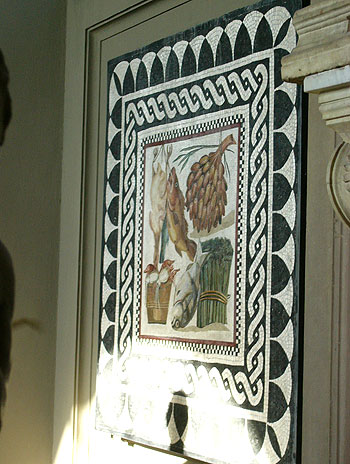
Roman food mosaic. Vatican. 2005. © Sue Schenk
This entry is about food in Rome, the ancient empire. There will be at some point a separate entry on food in modern-day Rome, the city.
Rome was founded, historians believe, by 625 BC (though the Romans themselves believed their city was founded in 735 BC.) The last Emperor (Romulus Augustus) was tossed out in 476 AD, about 1100 years later. If we think that the past 100 years have changed the food we eat, imagine how much Roman food would have changed over 1100 years.
The Romans assigned a lot of symbolism to their food, but it was far more class symbolism than religious. They were very much like us today in this, except that some of the symbols are now reversed: now, people consider it better to eat brown bread, and brown bread is more expensive than white. To a Roman, if you ate brown bread, you were a peasant. They were snobs not only about what you ate and how you ate it: whom you ate it with told them as well not only whether you were Roman or not, but what your place was in society. The upper class, for instance, would never eat out in public, commercial places that sold food. The taverns that sold food were called “Popinae”, where people sat on stools around tables to eat. Only the lower classes went to them.
Roman dining varied widely depending on how much money you had. Our movies and popular culture have focussed on what the extremely wealthy have eaten, but they were a minute percentage of the population. It would be like someone a thousand years from now thinking we all dined at the White House or Buckingham Palace.
Romans had many minor influences on their food — as food came in from various parts of the expanding empire — and perhaps two major influences. Their own Roman agricultural roots, which continued to be seen as a noble ideal throughout the history of the Empire, and the Greek influence. The wealthier Romans had Greek slaves, who would cook for them. R.W. Davies in “The Roman Military Diet,” in 1971 writes that there is archaeological evidence that Roman soldiers in the northern provinces would eat more meat than people back in Italy, and even acquired a taste for beer. And certainly as more Gauls and Germans became Roman soldiers, they would have brought their preferences into the army and back to Rome.
Much of Roman food was based on combining sweet, sour and savoury tastes all in one dish, just as Chinese food still does today. The taste for seasoning dishes in this way not only survived the fall of Rome, it remained the practice through the Dark Ages, the Middle Ages and right up until it was finally overthrown by the revolution in French cooking that was to occur in the 1600s.
Much food that food writers think was introduced to Europe during the Arab occupation of Spain had actually already been in Europe up to a 1,000 years before that, with the Romans. In Pompeii, citron seeds and lemons seeds have been found, in addition to a fresco of citrus fruit in the House of the Fruit Orchard.
“Carbonised and mineralised citrus seeds are among those discovered at Pompeii. They date to the third and second century BCE – that is, well before the destruction of the town by the explosion of Vesuvius. Citrus fruit is also represented on a fresco of the House of the Fruit Orchard (I.9.5–7). The citrus fruits consumed at Pompeii were the citron (Citrus medica), a fragrant citrus fruit with a thick rind… and the lemon (Citrus limon).” [1]King, Helen. Citrus fruits at Pompeii. Module 3, Health and Well-being in the Ancient World. Open University. Accessed May 2020 at https://www.open.edu/openlearn/ocw/mod/oucontent/view.php?id=65957§ion=2.2
Some of these foods disappeared entirely from Europe under the wave of barbarians, with cultivation practices lost or trade routes cut off; others, such as melons and citrus fruit, may have survived in small, backwater areas of Italy, though there is often no solid evidence one way or another other than local belief.
See also: Roman Holidays
Roman Cookbooks
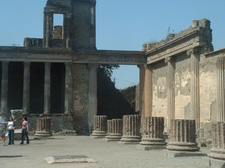
Pompeii. © Debrann Barr
Cookbooks are, for the most part, a modern invention. They really only got started in the late 1800s with the advent of wider-spread literacy amongst the common people like us, the affordability of paper, and a sense that it was worthwhile paying attention in print to hum-drum daily arcania such as recipes. There were a few cookbooks published, mostly in France, between the 1400s and the 1800s. Before that, though, the most noteworthy cookbook is that which is traditionally accredited to a Roman gourmand named Apicius. This is also believed to be the first cookbook ever written still extant, at least as far as we are aware of so far. [2]Though some argue that the Deipnosophistae by Atheneaus, written around 228 AD, should be called the first cookery book.
It’s important to note that the book is ascribed to someone named Apicius; the actual author is not known to us. We’re not even certain which Apicius the book is meant to be ascribed to — there are at least three good candidates. [3]There are three people named Apicius that we know of. One was a famous gourmet who lived at the time of Tiberius. Many people assumed that he was the one who wrote the cookbook. However, the cookbook was actually written in the late 4th or early 5th century, in a Latin that was already evolving away from itself. The author of this book is said by many sources to be a man named Caelius Apicius. Apicius is a family name meaning “bee-keeper.”
In any event, there were actually two cookbooks ascribed to Apicius: a first one on sauces, and then a second one which built on the first, called “de re Coquinaria” (“about things concerning cooking”.) The earliest surviving manuscript of that second book dates from the 9th century; it is almost complete. A man named Joseph Dommers Vehling did the first English translation of it in 1926. Though scholars trash Vehling’s translation, it is still the one most people turn to. The cookbook was clearly meant for a rich upper-class audience — which is understandable, because they are the ones who would have been able to read. It calls on expensive ingredients and has a great number of meat recipes, which would have been food that the likes of us in that time could only have dreamed of.
The division of the cookbook isn’t so different from how cookbooks are divided today:
- Epimeles: The Cook
- Sarcoptes: Meats
- Cepuros: From the garden
- Pandecter: Various dishes
- Ospreos: Peas, beans, lentils, chickpeas, etc.
- Aeropetes: Fowl
- Polyteles: Delicacies for the gourmet (truffles, etc.)
- Tetrapus quardripedia: Quadrupeds
- Thalassa mare: Seafood
- Halieus piscatura: Fish
To understand ingredients, we can also turn to a book written by Pliny the Elder (23-79 AD), called “Natural History” (“Historia naturalis”), and to books on farming such as “On Farming” (De Re Rustica) written by Marcus Porcius Cato (234 BC to 149 BC.)
Roman Meals
Regular Romans ate very simply, not like the obscenely wealthy ones portrayed in movies.
Meal patterns changed during the long history of the empire.
| Early Empire (Everybody) |
Late Empire (Ordinary People) |
Late Empire (Rich People) |
|
| Breakfast | Ientaculum | Ientaculum | Ientaculum |
| Noon meal | Cena (main meal) | Prandium (main meal) | Prandium |
| Evening meal | Vesperna | Vesperna | Cena (main meal) |
Ientaculum
The breakfast meal was called “Ientaculum”, though Romans weren’t big on breakfast, and it wasn’t a family meal. If you did eat something in the morning, it was some sort of bread, some wine, and cheese and/or fruit, and you likely ate it on the run.
Prandium
The term “prandium” didn’t become used until later in Roman times. For the wealthy, it would be a light, cold lunch. For ordinary people, it would often still be their main meal, and often be a one-pot dish as well.
Cena
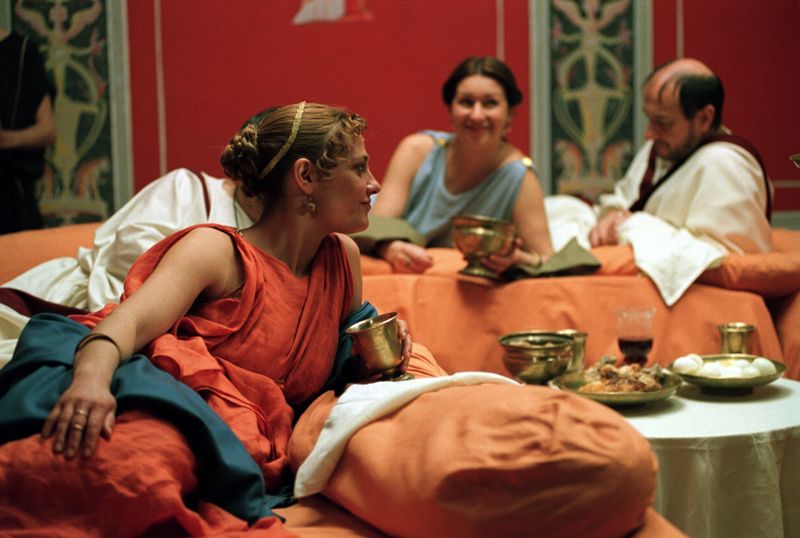
Reenactment of Roman dining in triclinium. Museo de historia de Valencia / wikimedia / 2003 / Public Domain
In early Roman times, the “cena”, the main meal of the day, was at midday for everybody. Later, the prandium at midday evolved, and cena shifted to the evening amongst the wealthy classes. The verb was “cenare”, which Romans speculated originally meant “to share”, but which they used to mean “to dine.” Italians still use these two words, “cena” and “cenare”, today to mean “dinner” and “to dine.” The dining room in a wealthy home was called either the “cenatio” or the “triclinium”, just depending on when and where the family lived (just as today some people say livingroom, others say frontroom or parlour.)
In wealthy homes, the cena would be a three part meal:
-
- starters: (called gustus, gustatio, antecina or promulis). A typical starter course involved eggs, usually boiled or poached.
- main meal (called “prima mensa”): the main part of the meal, which could be three or more courses (they were all numbered: cena prima, cena secunda, cena tertia, etc.)
- dessert (called “secunda mensa”): Cakes and/or fruit
A mensa was a table. Food would be brought in resting on small tables, thus the word for table came to be used to also mean a course of a meal.
Only adults would recline on couches; children would sit on stools. The cena was the only meal that would be eaten reclining. Only the wealthy ate their meals reclined.
Meat was not often served. It would be reserved for special occasions, except amongst the few hosts who were very rich and who practised conspicuous consumption (and were often mocked for this by Roman writers.)
Vesperna
This was the name for the evening meal for everybody in the early history of Rome, and remained the evening meal for ordinary people till the end of Roman times. There wouldn’t have been meat; the food would have been very plain and probably a one-dish meal, and certainly there wouldn’t have been couches for guests to recline on and servants pouring wine. Occasionally an ordinary family would serve meat for the evening meal, perhaps to celebrate birthdays, holidays or special events, and if meat was served, they would be more likely to refer to the meal as a “cena.”
Dairy in Rome
The writer Varro (in De Res Resticae 2 II 2) says that milk is the most nourishing of all liquids. He rated sheep’s milk first, then goat. Pliny, in his natural history (Book 28 33 124-9) says that goat’s milk is better for the stomach than cow’s milk.
That being said, in general, only Romans in the northern part of Europe drank milk as a beverage. As there was no refrigeration, milk in the warmer Italian peninsula would have gone off very fast unless you lived right on a farm where it was produced. The Romans did use milk a lot as a liquid to cook in. Apicius (I 8) soaks liver in honeywater, milk and eggs to soften its taste.
The Romans and the Greeks were aware that some people were lactose intolerant. In the Hippocratic book “On Ancient Medicine”, the writer wrote that some people suffered if they ate even a small amount of cheese, and the writer Celsus (in De Medicina 2 21) said that cheese can cause flatulence and constipation.
The Romans made butter only very occasionally, but generally didn’t eat it. When they did use butter, it was to put on a wound, as we do today on a burn (which is not the right thing to do, by the way.)
The Romans ate cheese a great deal. Roman soldiers had cheese as part of their rations.
Most of their cheeses were fresh cheeses, though the Romans fully understood the use of rennet to make hard-cheeses, and did. For coagulants, the Roman world used rennet from hare and goat kids, as well as fig tree branch sap, vinegar, thistle flowers, bastard saffron seed, thyme, and an extract from green pineapples. Columella felt that lamb rennet was the best.
It’s thought that it was the Romans who taught people in Northern Europe how to use rennet to make hard cheeses that last longer than fresh cheeses, and thus be transportable. There was a substantial trade within the Roman Empire in cheeses. This would have been hard cheeses though, as there was no refrigerated transport for fresh cheeses, which would have been produced and consumed locally.
Columella perhaps wrote the most about cheese, detailing how to make it, and urging the need for hygiene in cheese production. He explained that cooked-curd cheeses were made by cutting the curd, then scalding the curd by pouring boiling water over it.
In the first century AD, one street in the west side of the Palatine in Rome was famous for the cheese sellers in the street who sold smoked cheeses.
By the end of the 200s AD, cheese had become so basic a part of the Roman diet that the Emperor Dicoletian (284 – 305 Ad) set maximum prices for it.
A popular cheese in the second half of the 200s was a commercial cheese, thought to be the first branded cheese in the world that we know of, called “Lunar” or “La Luna” cheese. It was stamped with a trademark that depicted the “Horns of the Moon.” [4]Scott, R. Richard Kenneth Robinson, R. Andrew Wilbey. Cheesemaking Practice. New York: Kluwer Academic / Plenum Publishers. Third editon. 1998. Page 3.
The third century Roman writer Palladius reported that cheese was being made in Chester, England, at that point in time.
Most Roman recipes for cheese that have come down to us call for sheep’s or goat’s milk. When Pliny the Elder writes in the first century, he says that at the time, Goats Milk cheeses were the most popular. He also pronounces a cheese from what is now France to be the best:
“The kinds of cheese that are most esteemed at Rome, where the various good things of all nations are to be judged of by comparison, are those which come from the provinces of Nemausus, [Ed: Nîmes] and more especially the villages there of Lesura and Gabalis; but its excellence is only very short-lived, and it must be eaten while it is fresh.
The pastures of the Alps recommend themselves by two sorts of cheese; the Dalmatic Alps send us the Docleatian cheese, and the Centronian Alps the Vatusican. The kinds produced in the Apennines are more numerous; from Liguria we have the cheese of Ceba, which is mostly made from the milk of sheep; from Umbria we have that of Æsina, and from the frontiers of Etruria and Liguria those of Luna, remarkable for their vast size, a single cheese weighing as much as a thousand pounds.
Nearer the City [Ed: Rome], again, we have the cheese of Vestinum, the best of this kind being that which comes from the territory of Ceditium.
Goats also produce a cheese which has been of late held in the highest esteem, its flavour being heightened by smoking it. The cheese of this kind which is made at Rome is considered preferable to any other; for that which is made in Gaul has a strong taste, like that of medicine.
Of the cheeses that are made beyond sea, that of Bithynia is usually considered the first in quality. That salt exists in pasture-lands is pretty evident, from the fact that all cheese as it grows old contracts a saltish flavour, even where it does not appear to any great extent; [Ed: Pliny is speaking of Bithynian pasture-lands and cheese] while at the same time it is equally well known that cheese soaked in a mixture of thyme and vinegar will regain its original fresh flavour.” — Pliny the Elder, The Natural History. Book 11 97 .
In 2002, a Dr. Luigi Capasso (State University G. d’Annunzio in Chieti, Italy) analysed a piece of cheese that had been carbonized in Pompeii. He found that it was made of goat’s milk, and that it carried brucellosis, which was a disease of the joints very common in Roman times. His feeling is that it shows that goat’s milk cheese was a major source of the disease in the Roman Empire. As well, tuberulosis of the bone has been found in the British Roman town what is now Poundbury in Dorset, England, which some people speculate could have been caused by drinking infected milk.
Meat in Rome
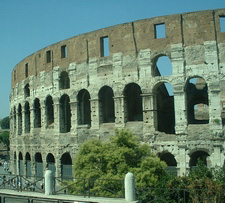
Colosseum aka Amphitheatrum Flavium. © Debrann Barr
Beef was only eaten on very special occasions. Cattle were needed instead to pull ploughs. Romans ate pork, mutton and veal; the lower classes also ate goat.
That being said, meat was eaten only sparingly, because it was seen as decadent and / or barbaric. While normal Roman meals were often meatless, though, people would have been insulted if a banquet did not include meat. Meat would make appearances mostly at special occasions such as these.
The Romans considered the Germanic tribes barbarians because they relied so heavily in their diets on meat and animal products. When an animal was killed to be eaten, it would be done first as a sacrifice, to the household gods or to public gods, as a way of showing respect for the life that was being taken. It would have been seen as beyond the pale to just butcher an animal for food without dedicating it to a god first. At home, the sacrifice would be to household gods. Butcher shops would sell meat that had been sacrificed in the public temples.
Christianity came to see sacrifice as cruel, even though Christians still slaughtered animals anyway. How to live with other people’s practices such as this was a dilemma for the early Christians, until Christianity decided the best way was to deal with this to simply ban all practices except its own. With Christianity and Northern European influences, where meat was the main item in the diet, meat would become “deconsecrated”, paving the way for it to become the normal food item that it has become today.
From the 200s on, not only bread but also pork was distributed to the people in times when they needed quietening.
The early Romans didn’t eat fish very often. Later on fresh fish were a delicacy, as were oysters. Some writers looked on fish as a decadent luxury.
The verb “to dine” (“cenare”) originally meant “to share” (Romans believed this was the history of the word, at any rate), as in to share the meat from a sacrifice in a communal fashion.
Grains in Rome
The Romans saw grain as an essential. They preferred vegetables to grain, but grain was something that could be stored against famine. Having grain meant that people weren’t reduced to combing the woods for acorns and chestnuts, something that would have been seen as barbaric and beneath the dignity of a Roman citizen, however lowly or poor. In giving its citizens free grain during time of war or famine, the government was protecting its citizens dignity. The free grain allowance was called the “annona.” There was no profit in growing grain in Rome. It was seen as a citizen’s basic right, so it had to be sold at a cost dictated by the state, or even at times distributed free.
The “breadbaskets” of the Roman world were Egypt, Libya, Algeria, Southern France and Sicily. Egypt produced both the most grain by far, and the grain most prized. Egypt continued to be the breadbasket of the ancient world until it was conquered by the Arabs, and its millennia old wheat and grape crops perished.
The Romans liked high gluten wheat because of the chewy, stable loaves it made. Barley flour bread was for slaves or soldiers being punished. Barley, millets and oats were considered only fit for the poor. Rye was grown only in the northern part of the Roman Empire, as it was a grain that tolerated the cold.
In the early stages of the Roman Empire, most grain was consumed in the form of puls: grains cooked in water.
In the “BC” portion of Rome’s history, spelt was largely unknown except in the northern provinces, as it was a central European grain. The Romans did use Emmer, aka “farro” (emmer grains were called “alica”), though they came to prefer the wheat we grow today (“Triticum aestivum”.)
Puls (Pulmentum)
Puls, a boiled wheat porridge, was an important part of the diet in early Rome, before they adopted the habit of using bread as a staple in their diet. Meat or veg could be added to make a stew. Pulmentum could also be made thicker, making it an early precursor to the dish we now know as polenta.
Cato the Elder (234 BC – 149 BC) was annoyed with the switch in preference from puls to bread; he thought bread was decadent.
Flours in Rome
By the 1st century, the preference was definitely for white bread made from white flour. Pure wheat flour was called “siligo.” Second rate breads would be made of wheat with the bran still in them, or of just the bran. In the cheapest breads, dried ground beans, chick peas, green peas and lentils would be mixed in with the flour.
In Caesar’s time, a man named Vitruvio, who also wrote “De Architectura”, invented the use of water wheels to power flour-grinding mills. They began to be more widely used in the first century AD.
Roman Bakeries
Professional bakers were common in the eastern Mediterranean. The Greeks felt that the best bakers were, in this order, the Cappadocians, the Lydians, and then the Phoenicians. The habit of buying professionally baked bread from a shop seems to have come to Rome sometime around or after 280 BC. Before that, bread was baked at home — perhaps part of the reason that Puls remained a dietary staple as it was easier to make than bread.
A bakers’ guild was formed around 168 BC. Called the Collegium Pistorum, it was an important, respected guild. Bakers could become wealthy. By Augustus’ time (31 BC – 14 AD), there were over 250 bakeries in Rome. Modern estimates put their output at 500,000 loaves a day.
A bakery was called a “pistrinum.” Many bakeries ground the grain as well, thus the alternative word “Pistorum”, meaning “grinders.” The mills for grinding would be turned by asses or horses.
Bakeries had large bowls made of volcanic stone for dough kneading, with the blades turned by animals or slaves. The oven doors would be made of iron. Bakeries would keep on hand baking pans made of bronze for making cakes with. Bakeries even made dog biscuits.
Most Romans in Rome lived in apartments without kitchens, let alone ovens, so they couldn’t bake their own bread. They would buy bread from the bakeries.
Whenever they were given free grain by the state, they would often take most of it to a bakery to grind it for them into flour and make bread from it for them. They still had to pay the bakers for the milling and bread-making, so rather than receiving free grain, it perhaps more accurate to say they got cheap bread (as only the grain part was free.)
Wealthier homes could bake their own bread in their own ovens, but even they still seemed to send their grain out to millers for grinding.
Bread in Rome
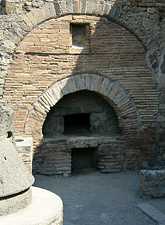
Bread oven at Pompeii. © Sue Schenk
Roman bread loaves were generally circular and flat, but you could get them in different shapes such as birds or musical instruments such as a lyre for special occasions. Bakers would also make different designs on them, just as we do today. They were often marked with notches to make them easier to break (and to share.) Bread was also made in stick shapes like baguettes.
Bread was, of course, made in different ways depending on which part of the Empire it was made in. In the province of Egypt, bread was made with “barm” (live yeast from beer brewing), as was bread in northern Gaul and other provinces. But on the peninsula of Italy itself, beer was viewed as a barbarian’s drink, and wine was made instead. Wine yeast, though, isn’t good for making bread from. Consequently, the Romans in Italy made their bread instead with “starter”, a bit of dough left over from previous batches, as in done with sourdough bread today.
Soldiers were given bread each day, and not allowed to sell or trade it. Warriors were considered heavy-bread eaters, not heavy meat-eaters, as they are now. Our current association of a warrior being a hearty meat-eater is owing to later Germanic influence.
The art of making finer breads was lost for centuries after Rome fell.
Some Roman bread types:
| Description | Name |
| Small rolls, also oily honey cakes | libae |
| Bread made from coarse grains other than wheat. Very cheap | panis primis |
| Bread made from coarse grains, a little better and a little more expensive | panis secundus |
| Bread made from coarse wheat flour | panis plebeius / panis cibarius |
| Camp or soldiers bread, made from wheat flour with bran | panis castrensis, panis militaris |
| Dark bread made from bran alone | panis durus ac sordidus |
| Country class or rustic bread, made from bran | panis rusticus |
| Bread made from white wheat flour | panis siligineus / siligeces. Made from pure white wheat called “siligo.” Contained no bran. |
| Bread that, instead of being sourdough based, would have been made from barm on the top of beer that is being brewed. Made in Gaul. | panem gallicanorum |
Roman Fish Sauces
We know that some of the most famous fish sauces were made from certain fish: “garum” from mackerel, and “muria” from tuna. Other fish sauces, though, could be made from any mixture of fish. In Judaea, there was even a kosher fish sauce — which implies that no shellfish were used, which in turn implies that sometimes shellfish might have been included in Roman fish sauces. Roman Foodies considered the fish sauce made from mackerel — “garum” — to be the best.
Water in Rome
It’s a myth that Romans weren’t aware of lead poisoning. They were, and were very conscious of it. They used lead a lot in the early days, but over time noticed the effects on those who worked with it or who wore it in cosmetics. Consequently, they avoided the use of lead in pipes for water. Rome had a very safe, reliable water supply.
The engineer and architect Vitruvius documented the issue:
“Water conducted through earthen pipes is more wholesome than that through lead; indeed that conveyed in lead must be injurious, because from it white lead is obtained, and this is said to be injurious to the human system. Hence, if what is generated from it is pernicious, there can be no doubt that itself cannot be a wholesome body. This may be verified by observing the workers in lead, who are of a pallid colour; for in casting lead, the fumes from it fixing on the different members, and daily burning them, destroy the vigour of the blood; water should therefore on no account be conducted in leaden pipes if we are desirous that it should be wholesome. That the flavour of that conveyed in earthen pipes is better, is shewn at our daily meals, for all those whose tables are furnished with silver vessels, nevertheless use those made of earth, from the purity of the flavour being preserved in them.” [5]Marcus Vitruvius Pollio (c. 80–70 BC to c. 15 BC). In “De Architectura.” c. 25 BC . Book 8. Chapter 6. Para 10 and 11. (Translated by Joseph Gwilt, London: Priestley and Weale, 1826.)
The Romans brought in water to the cities from long distances via tunnels through rock, channels on top of aqueducts, and through ceramic pipes. They preferred hard water, not only for its tastes, but because the calcium in it, which we dislike because of how it coats things, would make any leaks starting to emerge in the pipes self-sealing.
The water in Herculaneum had more fluoride in it; this could be a possible reason for them having had better teeth than their neighbours in Pompeii:
“25 per cent of people from Pompeii had at least one dental abscess but the individuals from Herculaneum had much better teeth. The levels of fluoride in the water were higher in Herculaneum, which may explain this.” [6]King, Helen. Healthy bodies in the ancient world. Module 6, Health and Well-being in the Ancient World. Open University. Accessed May 2020 at https://www.open.edu/openlearn/ocw/mod/oucontent/view.php?id=65966§ion=1.2
See the main entry on water for more details on Romans and water.
Wine in Rome
Drinking wine straight up was considered barbaric by Romans.
They always cut it with water, generally 1 part wine to 3 parts water. The Roman writer Pliny the Elder mentions that seawater could also be used to cut the wine with. They would also make mulsum, mixing the wine with honey. Many parts of Italy still dilute their wine with water — this is called “tagliare” (to cut) the wine.
The Romans considered the best wines to be made at Falernia, near Naples.
The Romans hadn’t mastered the art of being able to preserve wines for years without their going bad; after all, they only had amphora crocks to keep it in. (Though they knew how to make glass tableware, and did, the idea of glass bottles for wine doesn’t seem to have occurred to them.) Cato (Marcus Porcius Cato 234 BC to 149 BC) in “On Farming”, gives many ways to trying to preserve wine and how to rescue wine that has gone bad despite all these attempts.
The Roman writer, Pliny the elder, said that there were four colours of wine:
“Vinum omne dulce minus odoratum; quo tenuius, eo odoratius. Colores vinis quattuor: albus, fulvus, sanguineus, niger.” (“All the luscious wines have but little aroma: the thinner the wine the more aroma it has. The colours of wines are four, white, brown, blood-coloured, and black.”) — Pliny. Natural History. Book 14. Chapter 11.
The ancient Greeks called red wine “black wine.” Food historians speculate they called it that because in the earthenware drinking vessels they had, it would have appeared black. The Romans picked up the term as well, even though in the later Roman Empire they had glasses to drink from.
Literature & Lore
“De gustibus non disputandum est.” (There’s no point arguing about taste.) — Unknown (often wrongly attributed to Cicero or Caesar; it may just have been a common proverb.)
“Let us be sacrificers, but not butchers, Caius.” — William Shakespeare (26 April 1564 – 23 April 1616. Julius Caesar. Act II, Scene 1.)
Sources
Alcock, Joan P. Milk and its Products in Ancient Rome. In: Milk: Beyond the Dairy : Proceedings of the Oxford Symposium on Food and Cookery 1999. Harlan Walker, editor. Oxford Symposium. 2000-08-01.
References
| ↑1 | King, Helen. Citrus fruits at Pompeii. Module 3, Health and Well-being in the Ancient World. Open University. Accessed May 2020 at https://www.open.edu/openlearn/ocw/mod/oucontent/view.php?id=65957§ion=2.2 |
|---|---|
| ↑2 | Though some argue that the Deipnosophistae by Atheneaus, written around 228 AD, should be called the first cookery book. |
| ↑3 | There are three people named Apicius that we know of. One was a famous gourmet who lived at the time of Tiberius. Many people assumed that he was the one who wrote the cookbook. However, the cookbook was actually written in the late 4th or early 5th century, in a Latin that was already evolving away from itself. The author of this book is said by many sources to be a man named Caelius Apicius. Apicius is a family name meaning “bee-keeper.” |
| ↑4 | Scott, R. Richard Kenneth Robinson, R. Andrew Wilbey. Cheesemaking Practice. New York: Kluwer Academic / Plenum Publishers. Third editon. 1998. Page 3. |
| ↑5 | Marcus Vitruvius Pollio (c. 80–70 BC to c. 15 BC). In “De Architectura.” c. 25 BC . Book 8. Chapter 6. Para 10 and 11. (Translated by Joseph Gwilt, London: Priestley and Weale, 1826.) |
| ↑6 | King, Helen. Healthy bodies in the ancient world. Module 6, Health and Well-being in the Ancient World. Open University. Accessed May 2020 at https://www.open.edu/openlearn/ocw/mod/oucontent/view.php?id=65966§ion=1.2 |

